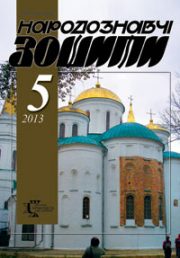The Ethnology Notebooks. 2021. # 1 (157), P. 148—156
УДК 792.071.1:37.01](477)*19*
DOI https://doi.org/10.15407/nz2021.01.148
Natalia RUDENKO-KRAEVSKA
- ORCID ID: https://orcid.org/0000-0001-6554-5325
- Senior teacher of the Department of Monumental Painting
- Lviv National Academy of Arts,
- 38, Kubiyovycha st., 79011, Lviv, Ukraine,
- e-mail: mytsa.lv@gmail.com
THEATRICAL DESIGN CHARACTERS FOR TETYANA MEDVID MASKS, FIGURES, COSTUMES
Masters of Ukrainian scenography, accumulating previous experience of European and domestic theatrical art of the last quarter of the 20th century, actively sought new approaches to the embodiment of the visual image of the action within the third system of visual directing performances. One of the outstanding Ukrainian scenographers-reformers was the chief artist of the Kharkiv Academic Drama Theater named after Taras Shevchenko «Berezil», Tatiana Medvid.
The article examines the scenographic projects of Tatiana Medvid, which were created in different years, in Ukrainian theaters, with different directors, but combined with one artistic technique — the creation of scenographic characters in the form of masks, costumes and figures. The relevance of the article is due to the fact that, first, today we cannot talk about a thoroughly researched history of Ukrainian scenography, nor about the formed picture of current practices and trends in the work of contemporary Ukrainian theater artists; secondly, very little has been written about Kharkiv’s theatrical artists, in particular about T. Medvid’s work, mainly in periodicals and reviews of premiere performances, and the phenomenon of Tatiana Medvid’s work has not been studied in any monograph or other scientific work.
The purpose of the research is to analyze the existence of scenographic characters in the form of masks, figures and costumes within the system of effective scenography in terms of creating a visual image of the play, acting with the subject world, determining the degree of concretization of place and time and organization of theatrical space. The object of research is a visual and figurative series of dramatic performance, as an integral part of theatrical synthesis. The subject of research — scenographic projects of Tatiana Medvid: «Threepenny Opera» by B. Brecht (1975) «The courtship at Goncharivka» by G. Kvitka-Osnovyanenko (1978), «The Way» by O. Bilyatsky and Z. Sagalov (1984), «Dreams of Christian» by the work of G.H. Andersen «Olle Lukoye» (1995), E. Ionesco «Macbeth» (1996) on the big stage of the Kharkiv Academic Drama Theater after Taras Shevchenko; Jean Anuy’s «Antigone», M. Kulish’s «Macleana Grasse» (1993) staged on the Small Stage «Berezil» and «Caligula» by Albert Camus (1998) at the Donetsk Academic Ukrainian Music and Drama theater after Artem. Research methodology — is to use the method of primary sources, conceptual analysis and the method of theoretical generalization.
Keywords: scenography, scenographic character, Tatiana Medvid, mask, figure, costume.
REFERENCES
- Berezkin,V. (2006). The art of scenography of the world theater. Artist’s Theater. Origins and beginnings. Moskva: Kom Book [in Russian].
- Chepalov, O. (1989, 18 june). Master of figurative scenography. Socialist Kharkiv. Kharkiv [in Ukrainian].
- Sedunova, O. (1997). Ionesco «Macbeth». Art line, 3. Kyiv [in Ukrainian].
- Korobov, D. (1997, 3—9 january). Butterfly hunter and tyrant. Grani, 1053 [in Russian].
- Mizyak, V. Cultural dimensions of directing practices in drama theaters of Kharkiv in the second half of the 20th — early 21st century. Retrieved from: chrome-extension: //mhjfbmdgcfjbbpaeojofohoefgiehjai/index.html (appeal date: 1.11.2020) [in Ukrainian].





